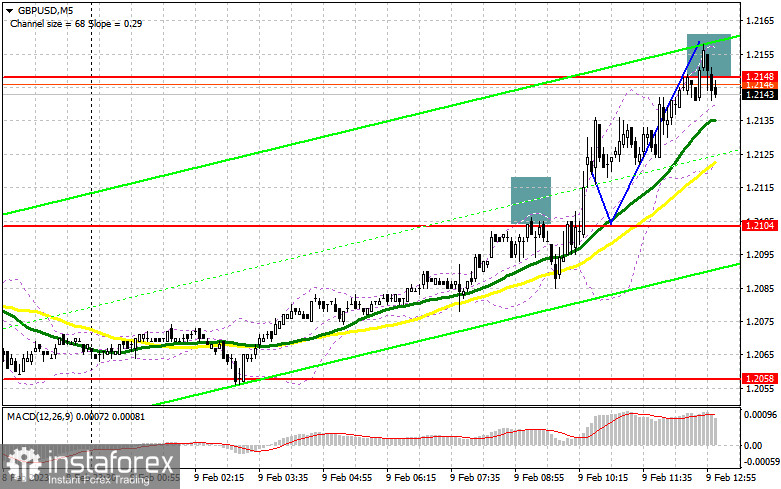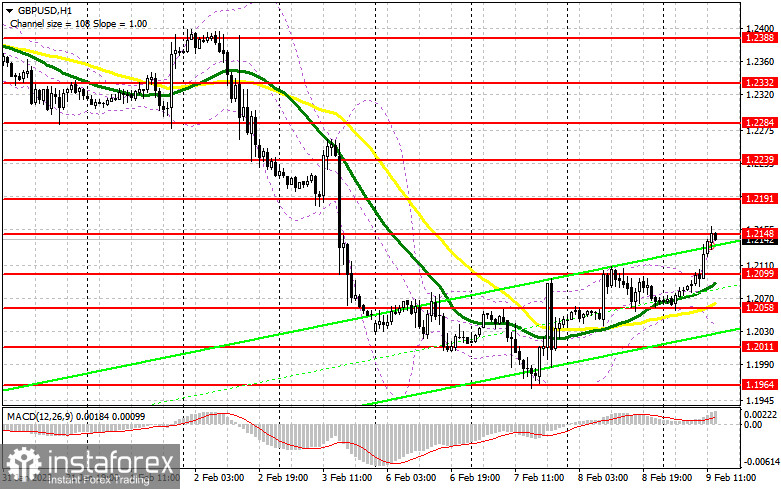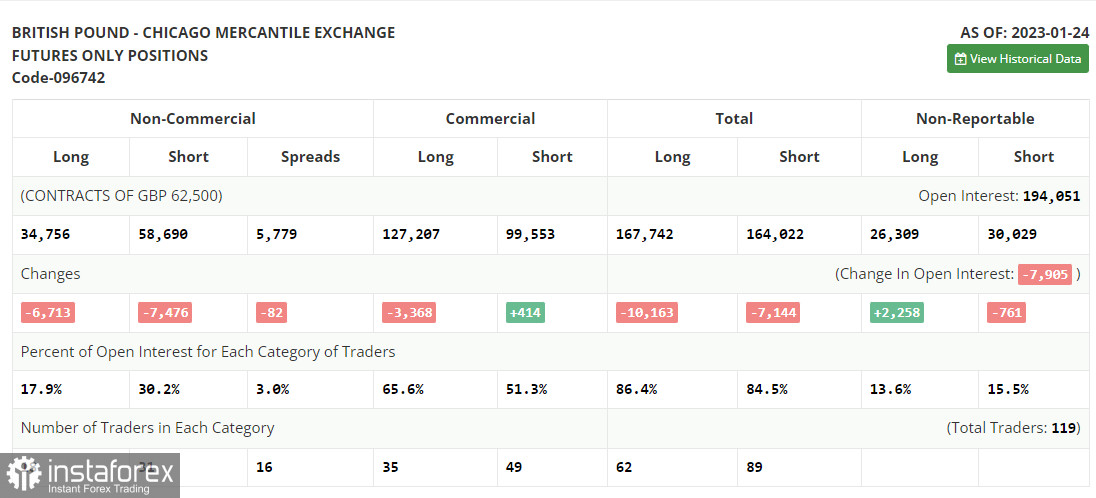Long positions on GBP/USD:
In my previous forecast, I drew your attention to the level of 1.2104 and recommended entering the market from it. Let's have a look at the 5-minute chart and analyze the situation. The surge of the British pound in the morning resulted in a false breakout at 1.2104. However, it did not decline deeply. As a result, I had to fix the losses as bulls broke above 1.2104. Parliamentary hearings on inflation caused another surge that pushed the pair to a new resistance of 1.2148. In addition, the pair gave a sell signal at this level. As long as the pair is trading below this level, we may expect a deeper drop.

The US dollar sagged in the first half of the day and it needs strong US labor market data, showing a decline in the number of new jobless claims, to recoup losses. Only then we will be able to see the GBP/USD pair moving down to 1.2099, a new support level. A false breakout at 1.2099 above the moving averages, which support bulls, is likely to confirm that big buyers have returned to the market and give an entry point with the target located at the resistance of 1.2148. If the price fixes above this level and tests it from above, the bullish trend may continue, sending the pair to the high of 1.2191, where traders may book their profits. If bulls fail to protect 1.2099, bears will return to the market. This will increase the pressure on the pair in the afternoon. For this reason, it would be better to open long positions after the price declines and forms a false breakout near the next support of 1.2058. One may also buy GBP on a rebound from 1.2011, allowing an intraday correction of 30-35 pips.
Short positions on GBP/USD:
Bears tried to push the pair down but their attempts came to nothing. The price broke through strong resistance that triggered a lot of stop-loss orders. Thus, the pair increased sharply. If the data on the US labor market comes in line with expectations, most likely, the rise of the British pound will continue in the second half of the day. In this connection, bears need to increase their activity near 1.2148. Another false breakout at this level will give a sell signal with the target at 1.2088, a new support level, which was formed after the first half of the day. A breakthrough and a downward test of this level may strengthen bears' position in the market and create a sell signal, dragging the price down to 1.2058. Testing this level, the pair is likely to return to the sideways channel. The next target is located in the area of 1.2011 but the price is unlikely to reach it today. If the GBP/USD pair rises and bears show weak activity at 1.2148, which is more likely, bulls may take control of the market. In that case, only a false breakout near 1.2191 may give an entry point into the short positions. If we see no trading activity there, it would be better to sell GBP from the high of 1.2239, counting on an intraday downside rebound of 30-35 pips.

COT report
The COT report from January 24 logged a sharp drop in long and short positions. However, the current decline was quite acceptable. The fact is that the UK government is coming across tough times. It is struggling with strikes and demands to raise wages and at the same time, it is trying to achieve a steady decline in inflation. However, this is of less importance at the moment since traders are waiting for the meetings of the Fed and the BoE. The Fed is expected to switch to a less hawkish stance, whereas the BoE may remain aggressive, refraining from increasing the interest rate by 0.50%. This may have a positive effect on the pound sterling. That is why I will bet on its further rise. The recent COT report showed that the number of short non-commercial positions decreased by 7,476 to 58,690, while the number of long non-commercial positions decreased by 6,713 to 34,756. As a result, the negative value of the non-commercial net position dropped to -23,934 from -24,697 a week earlier. Such minor changes will hardly affect the market situation. Thus, we will continue to closely monitor the economic indicators for the UK and the decision of the Bank of England. The weekly closing price rose to 1.2350 against 1.2290.

Signals of indicators:
Moving averages
Trading is carried out above 30- and 50-day moving averages. This indicates that GBP may rise.
Note: The author considers the period and prices of moving averages on the one-hour chart which differ from the general definition of the classic daily moving averages on the daily chart.
Bollinger Bands
If the pair declines, the lower band of the indicator near 1.2040 will act as support.
Description of indicators
- Moving average determines the current trend by smoothing volatility and noise. Period 50. Marked in yellow on the chart.
- Moving average determines the current trend by smoothing volatility and noise. Period 30. Marked in green on the chart.
- MACD indicator (Moving Average Convergence/Divergence). Fast EMA 12. Slow EMA 26. SMA 9.
- Bollinger Bands. Period 20.
- Non-profit speculative traders are individual traders, hedge funds, and large institutions that use the futures market for speculative purposes and meet certain requirements.
- Long non-commercial positions are the total number of long positions opened by non-commercial traders.
- Short non-commercial positions are the total number of short positions opened by non-commercial traders.
- Total non-commercial net position is a difference in the number of short and long positions opened by non-commercial traders.
 English
English 
 Русский
Русский Bahasa Indonesia
Bahasa Indonesia Bahasa Malay
Bahasa Malay ไทย
ไทย Español
Español Deutsch
Deutsch Български
Български Français
Français Tiếng Việt
Tiếng Việt 中文
中文 বাংলা
বাংলা हिन्दी
हिन्दी Čeština
Čeština Українська
Українська Română
Română

